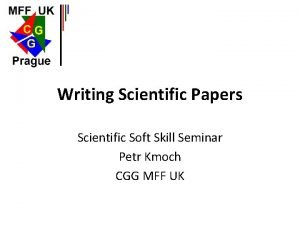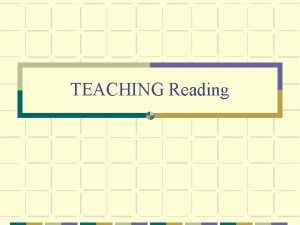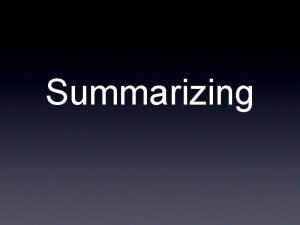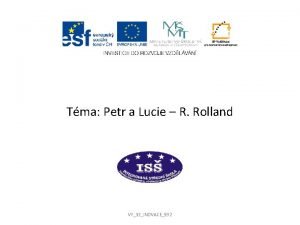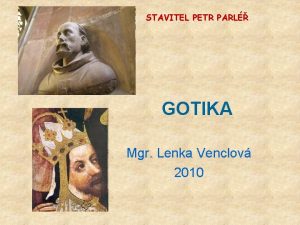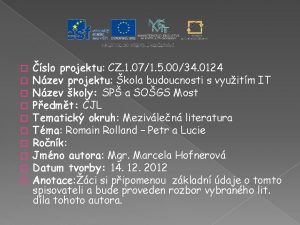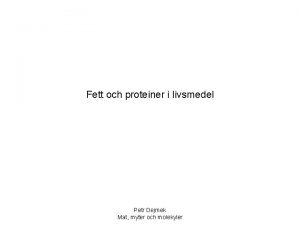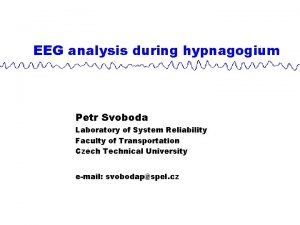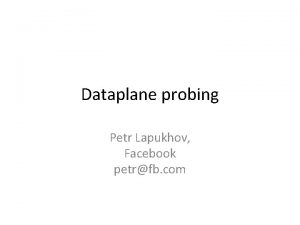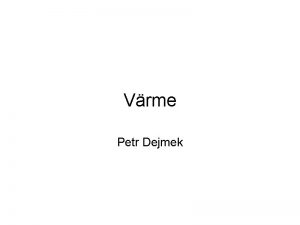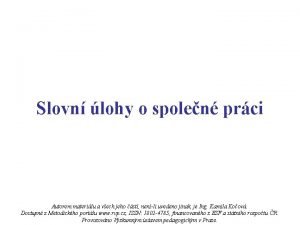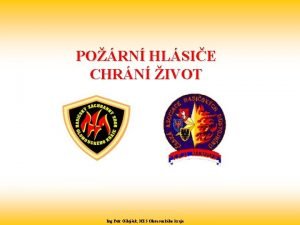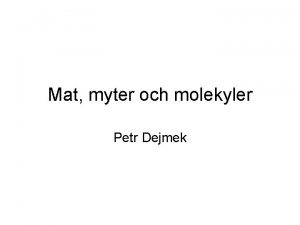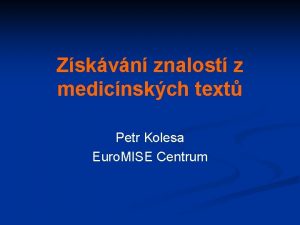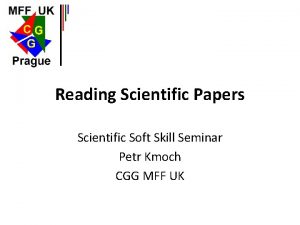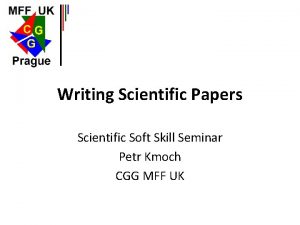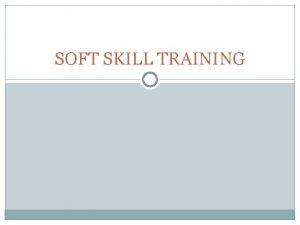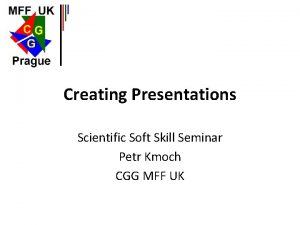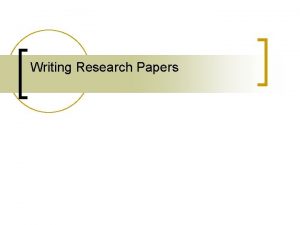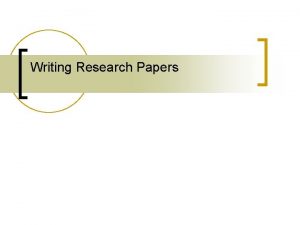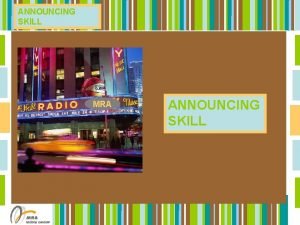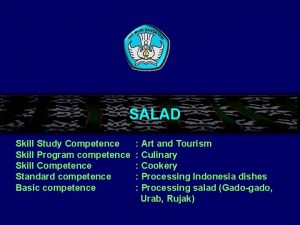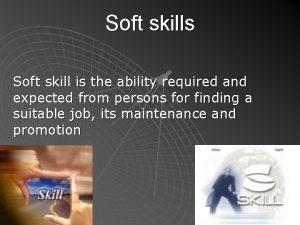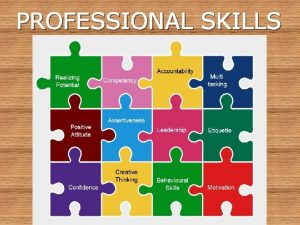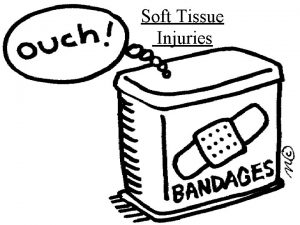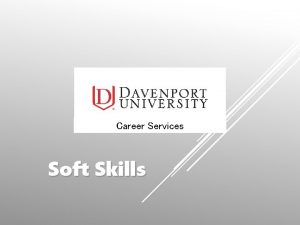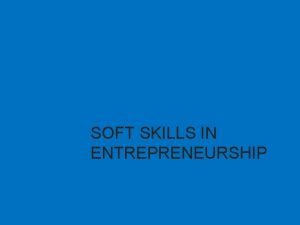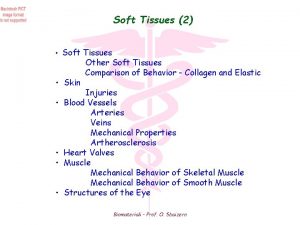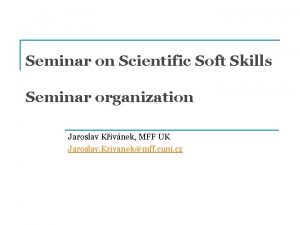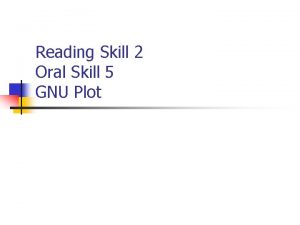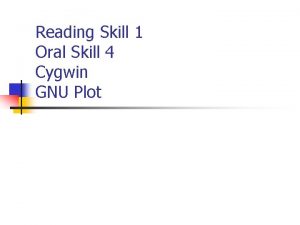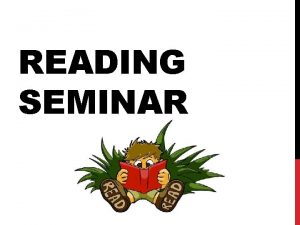Reading Scientific Papers Scientific Soft Skill Seminar Petr



























- Slides: 27

Reading Scientific Papers Scientific Soft Skill Seminar Petr Kmoch CGG MFF UK

Reading Scientific Papers § What? !? § It’s simple, right? “Read them, ” said the King. “Where shall I begin, please your Majesty? ” “Begin at the beginning, ” the King said gravely, “and go on till you come to the end, then stop. ” —Lewis Carroll, Alice in Wonderland § Well, not quite ; -) Petr Kmoch, Computer Graphics Group, MFF UK 2

Presentation Outline § Reading goals & types § With examples § Paper processing § Useful tips Petr Kmoch, Computer Graphics Group, MFF UK 3

Presentation Outline § Reading goals & types § With examples § Paper processing § Useful tips Petr Kmoch, Computer Graphics Group, MFF UK 4

Typical Paper Structure § Abstract § Introduction Topic overview § Contribution summary § § § State of the art Contribution Results Conclusion Future work Petr Kmoch, Computer Graphics Group, MFF UK 5

Goals of Reading § § § Learn specific info Keep up to date Assert novelty Broaden perspectives Write a review Implement Petr Kmoch, Computer Graphics Group, MFF UK 6

Reading Types § Reading types Scan (what) 2. Read (how) 3. Save 4. Learn (why) 1. § Different purpose different type Petr Kmoch, Computer Graphics Group, MFF UK 7

1. Scan § Goal: Evaluate paper relevance § Output: now / later / not at all § Title, authors, abstract, introduction, results, conclusion § Year § Section titles, figures § Trust authors’ claims Petr Kmoch, Computer Graphics Group, MFF UK 8

1. Scan – Practical Tips § Title “keywords” § “implementation”, “application” § § “survey”, “overview”, “review” § § just STAR “X-based Y” § § existing method without changes X is old, Y can be new “framework” § § multiple method compilation, down-to-earth results often many self-citations Petr Kmoch, Computer Graphics Group, MFF UK 9

2. Read § § § Goal: Understand what is done & how More than one reading necessary Connection to other papers Formulae, descriptions Be doubtful about authors’ claims Look for “fine print” § Find weak spots § § Look in Future work Petr Kmoch, Computer Graphics Group, MFF UK 10

2. Read – Practical Tips § Parameter values not given § difficult to tune; far from real-world values § Important parts missing § § referred to other papers referred to “textbooks, literature, . . . ” § No implementation § look for concrete results (timings, precision, . . . ) § Narrow comparison range § method is data-sensitive § Text instead of formulae § formulae complex, illogical or ad hoc § Claims rebutted by newer papers Petr Kmoch, Computer Graphics Group, MFF UK 11

3. Save § § § Goal: Create reference for the future Summarize paper in your own words Annotate important formulae Stress pros & cons Write down full Bib. Te. X entry § Rendered bibliographic entry also useful Petr Kmoch, Computer Graphics Group, MFF UK 12

3. Save – Practical Tips § Later. . . Petr Kmoch, Computer Graphics Group, MFF UK 13

4. Learn § Goal: Understand the paper inside out § Don’t believe any authors’ claims § Unless you can prove them § Cross-reference formulae § Write down full notation explanation § Read (type 2) all papers detailing methods employed Petr Kmoch, Computer Graphics Group, MFF UK 14

4. Learn – Practical Tips § Table of symbols § Know the why of formulae § Implementer’s view Data flow § Effects of “sketched” steps § External dependencies § § Resource-intensity § Evaluate combinability Petr Kmoch, Computer Graphics Group, MFF UK 15

Presentation Outline § Reading goals & types § With examples § Paper processing § Useful tips Petr Kmoch, Computer Graphics Group, MFF UK 16

Paper Sources § Faculty library § Digital libraries (ACM, IEEE, EG) § Faculty has (some) access § State technical library, CAS library § Cite. Seer(X) § Authors’ webpages § Not always the first author’s § Conference websites Petr Kmoch, Computer Graphics Group, MFF UK 17

Number Explosion § Easily 1000 s of papers § Processing ways Backtrack references § Method – old vs. Survey – new § Reference age § Venue, author affiliation § http: //iacl. ece. jhu. edu/projects/gvf_cite/snake_cite_year. html Petr Kmoch, Computer Graphics Group, MFF UK 18

Paper Management § Organizing saved data (type 3) § 100 s can accumulate fast § Stand-alone database § Files, actual DB, . . . § Bib. Te. X database Custom fields § Manager SW: Jab. Ref, . . . § § Hard copies with hand scribbles Petr Kmoch, Computer Graphics Group, MFF UK 19

Bib. Te. X § Structured text file § Entries § Article, Book, In. Proceedings, Ph. DThesis, . . . § Fields § title, author, year, publisher, . . . § Natively cooperates with La. Te. X § Different styles § MS Word integration exists Petr Kmoch, Computer Graphics Group, MFF UK 20

Sidestepping Reading § Knowledge needed Find a citing STAR or book § Find an “X-based” paper § § Implementation needed Authors’ webpages § Libraries where authors contributed § Software docs can include citations § MATLAB, Mathematica prototyping § Petr Kmoch, Computer Graphics Group, MFF UK 21

Presentation Outline § Reading goals & types § With examples § Paper processing § Useful tips Petr Kmoch, Computer Graphics Group, MFF UK 22

Reading Approaches § Papers vs. books § Cutting edge vs. tried & tested § Conference, journal, invited, STAR, thesis § User’s explanation § Method explained better in a citing paper § Semi-unrelated fields § Knowledge transfer & novel application Petr Kmoch, Computer Graphics Group, MFF UK 23

Keyword Dictionary § Real-time § >=20 -25 FPS § Interactive § 5 -10 FPS § Semi-automatic § (Expert) user cooperation necessary § Out of core § Too large for main memory Petr Kmoch, Computer Graphics Group, MFF UK 24

Keyword Dictionary (cont. ) § Image-based § 2 D, post-processing, IP methods § Sketch-based § User-interactive, fuzzy § Multi-dimensional vs. High-dimensional § 4 -5 vs. O(102) § Approximation § Expect ad hoc formulae and “magic numbers” Petr Kmoch, Computer Graphics Group, MFF UK 25

Keyword Dictionary (cont. 2) § Analytical, closed-form § Expressed as a formula § Pre-computed § Intensive pre-processing phase § Algorithm vs. Solution § Solution can be theory-only § Parallel vs. Distributed § Intra-case vs. Net-based Petr Kmoch, Computer Graphics Group, MFF UK 26

Thank you § Questions? § Answers Petr Kmoch, Computer Graphics Group, MFF UK 27
 Skills
Skills While reading activities
While reading activities Visi dan misi kementerian kesihatan malaysia
Visi dan misi kementerian kesihatan malaysia Soft skills conclusion
Soft skills conclusion Penilaian soft skill
Penilaian soft skill 6 key soft skill binus
6 key soft skill binus Soft skills seminar
Soft skills seminar Reading is a receptive skill
Reading is a receptive skill What is reading and types of reading
What is reading and types of reading How does summarizing help comprehension
How does summarizing help comprehension What is intensive reading
What is intensive reading Using science skills
Using science skills Petr lucie a tma
Petr lucie a tma Stavitel petr
Stavitel petr Petr měl obdélník šířky 2 cm a neznámé délky
Petr měl obdélník šířky 2 cm a neznámé délky Petr a lucie hlavní myšlenka
Petr a lucie hlavní myšlenka Petr a lucie kapitoly
Petr a lucie kapitoly Petr skryja
Petr skryja Petr iljič čajkovskij prezentace
Petr iljič čajkovskij prezentace Petr dejmek
Petr dejmek Hypnagogum
Hypnagogum Petr lapukhov
Petr lapukhov Petr dejmek
Petr dejmek Vnve
Vnve Petr dokáže udělat celou práci sám za 6 hodin
Petr dokáže udělat celou práci sám za 6 hodin Hlsie
Hlsie Petr dejmek
Petr dejmek Koleso text
Koleso text






